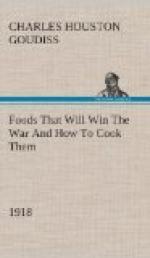SAVE FOOD
REASONS WHY OUR GOVERNMENT ASKS US NOT TO WASTE FOOD, WITH PRACTICAL RECIPES ON THE USE OF LEFTOVERS
Elimination of food waste is to-day a patriotic service. It is also a most effective method of solving our food problem. This country, like all the powers at war, will undoubtedly be called upon to face increasing prices so long as the war continues, and waste in any form is not only needless squandering of the family income, but failure in devotion to a great cause.
Food waste is due to poor selection of raw materials, to careless storage and heedless preparation, to bad cooking, to injudicious serving, and to the overflowing garbage pail.
To select food in such a way as will eliminate waste and at the same time insure the best possible return for money spent, the housekeeper must purchase for nutriment rather than to please her own or the family palate.
When eggs are sixty and seventy cents a dozen their price is out of all proportion to their food value. Tomatoes at five or ten cents apiece in winter do not supply sufficient nutriment to warrant their cost, nor does capon at forty-five cents a pound nourish the body any better than the fricassee fowl at twenty-eight cents. In order to prevent such costly purchasing, a knowledge of food values is necessary. The simplest and easiest way to plan food values is to divide the common food materials into five main groups and see that each of these groups appear in each day’s menu.
GROUP 1.—FOODS DEPENDED ON FOR MINERAL MATTERS, VEGETABLE ACIDS, AND BODY-REGULATING SUBSTANCES.
FRUITS
Apples, pears, etc.,
Berries,
Melons,
Oranges, lemons, all citrus fruits.
VEGETABLES
Salads, lettuce, celery,
Potherbs or “greens”
Tomatoes, squash,
Green peas, green beans,
Potatoes and root vegetables.
GROUP 2.—FOODS DEPENDED ON FOR PROTEIN.
Milk, skim milk, cheese,
Eggs,
Meat,
Poultry,
Fish,
Dried peas, beans, cow-peas,
Nuts.
GROUP 3.—FOODS DEPENDED ON FOR STARCH.
Cereals, grains, meals, flour,
Cereal breakfast foods,
Bread,
Crackers,
Macaroni and other pastes,
Cakes, cookies, starchy puddings,
Potatoes, other starchy vegetables,
Bananas.
GROUP 4.—FOODS DEPENDED ON FOR SUGAR.
Sugar,
Molasses,
Syrups,
Dates,
Raisins,
Figs.
GROUP 5.—FOODS DEPENDED ON FOR FAT.
Butter and cream,
Lard, suet,
Salt pork and bacon,
Table and salad oils,
Vegetable, nut, and commercial cooking
fats and oils.
If from each of these groups the housekeeper, when buying, chooses the lowest-cost food, she will provide the necessary nutriment for the least expenditure of money. In war time such marketing is essential.




